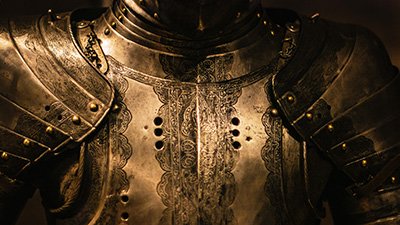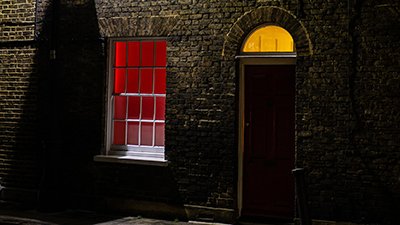
How Are Christians Instructed to Be Effective for God?
The Parables of Salt and Light, the Barren Fig Tree, and the Lost Sheep
When Jesus spoke to the multitudes, he often used subjects and imagery that were readily understandable to the people in the crowds. He used household objects, husbandry principles, and even shepherding as motifs in several parables. We’ll examine three of those that deal with commonly used or well-known items and how they represent what God expects from his followers and the consequences if we lose our passion for Christ.
Salt and Light—Matthew 5:13–16; Mark 4:21–25, 9:50; Luke 8:16–17, 14:34–35
You are the salt of the earth, but if salt has lost its taste, how shall its saltiness be restored? It is no longer good for anything except to be thrown out and trampled under people’s feet. You are the light of the world. A city set on a hill cannot be hidden. Nor do people light a lamp and put it under a basket, but on a stand, and it gives light to all in the house. In the same way, let your light shine before others, so that they may see your good works and give glory to your Father who is in heaven. (Matthew 5:13–16)
And he said to them, “Is a lamp brought in to be put under a basket, or under a bed, and not on a stand? For nothing is hidden except to be made manifest; nor is anything secret except to come to light. If anyone has ears to hear, let him hear.” And he said to them, “Pay attention to what you hear: with the measure you use, it will be measured to you, and still more will be added to you. For to the one who has, more will be given, and from the one who has not, even what he has will be taken away.” (Mark 4:21–25)
Salt is good, but if the salt has lost its saltiness, how will you make it salty again? Have salt in yourselves, and be at peace with one another. (Mark 9:50)
No one after lighting a lamp covers it with a jar or puts it under a bed, but puts it on a stand, so that those who enter may see the light. For nothing is hidden that will not be made manifest, nor is anything secret that will not be known and come to light. (Luke 8:16–17)
Salt is good, but if salt has lost its taste, how shall its saltiness be restored? It is of no use either for the soil or for the manure pile. It is thrown away. He who has ears to hear, let him hear. (Luke 14:34–35)
Matthew, Mark, and Luke all record a salt and light parable of Jesus but include different details, and Mark and Luke even detach the “salt” from the “lamplight” aspects. It is most likely that Jesus taught two (or more) separate parables with this same theme, with Matthew recording the one Jesus gave at the sermon on the mount, and Mark and Luke recording the lamplight portion in the list of parables right after the parable of the sower (while Jesus was teaching the people from a boat at the Sea of Galilee). Mark records the salt parable shortly after Jesus’ transfiguration (Mark 9:2–8), and Luke records the salt portion while Jesus is dining with a ruler of the Pharisees (Luke 14:34–35). Jesus likely told the same or similarly themed parables on multiple occasions. And just as speakers do today, he probably also changed up the order at times.
Preservation and Illumination
In Matthew’s account, Jesus connects his disciples (and by extension, all true Christians) to the best-known preservative of the time—salt. Salt not only flavored foods, but also dried and preserved meats. In times before refrigeration was available, salt was one of the only means of preserving food for more than a few hours.1 Jesus uses both aspects of salt in this parable—its savory aspect (saltiness) and its worth as a preservative. Once salt had lost its taste, it had also lost its preservation qualities. Like Matthew’s account, Luke also stressed that “tasteless” salt was therefore good for nothing. In Mark’s account however, there is an added element, namely that salt’s preservation qualities are compared to preserving peace among Christians. Jesus is saying here that if Christians are true salt (manifesting Christlike qualities of love and encouragement, they will strive for unity and peace among themselves.
Christians are to be a reflection of the light of God. When we dim or cover this light, it does not reach the world, and this can result in people not seeing our love for Christ, not hearing the gospel, and consequently not giving glory to God.
Likewise, the lamp analogy in these parables also points toward showing forth Christlike qualities of love and peace and, of course, pointing people to Christ as the only Savior and Light of the world (John 8:12, 9:5). Matthew records Jesus telling his disciples and other of his followers that they were also the light of the world and their light should not be hidden but should stand out to illuminate their good works, which would point to the source of those works—God the Father!
Mark and Luke add that light also exposes darkness and reveals hidden things. Oil lamps were common and necessary household objects, as they were the main source of light in a house once the sun set. Nobody would be foolish enough to cover their oil lamp as they were walking around their house at night. That would be an invitation for stubbed toes, bruised shins, and—as mentioned in Luke’s account—potential harm to guests entering the house after dark. Christians are to be a reflection of the light of God. When we dim or cover this light, it does not reach the world, and this can result in people not seeing our love for Christ, not hearing the gospel, and consequently not giving glory to God.
The Barren Fig Tree—Luke 13:6–9
And he told this parable: “A man had a fig tree planted in his vineyard, and he came seeking fruit on it and found none. And he said to the vinedresser, ‘Look, for three years now I have come seeking fruit on this fig tree, and I find none. Cut it down. Why should it use up the ground?’ And he answered him, ‘Sir, let it alone this year also, until I dig around it and put on manure. Then if it should bear fruit next year, well and good; but if not, you can cut it down.’”
Patience and Stewardship
This parable of Jesus is a short one, but it has several applications. The most obvious is the longsuffering of God. In this short parable, the owner of the land is almost certainly referring to God the Father. We have another figure in this particular parable though, the vinedresser (gardener in some versions), who is usually thought to be Christ.
God expects fruit (righteousness) out of his people (Romans 7:4; Galatians 5:22–23; Philippians 1:10–11; Colossians 1:10; James 3:17–18). But this fig tree had not had any fruit for three years. Notice that the vinedresser shows patience as well as diligence in his response to the landowner, which basically amounts to “Give me just one more year; let me dig around it to clear out the nutrient-poor soil and fertilize it.” Of course this analogy cannot be stretched too far, implying that the landowner is impatient and Jesus has to wheedle a concession out of his heavenly Father. We know from other passages in the Bible (Exodus 34:6; Psalm 86:15; Romans 2:4) that God the Father is longsuffering and patient, but even so, Scripture also tells us that Jesus is our Advocate with the Father when we sin (1 John 2:1). Jesus as both God and man understands our frailties and goes to the Father on our behalf. In this parable, Jesus is asking for additional time, but also for different and more nutrient-rich “soil.” Perhaps this is different circumstances, better health, more support from family and friends, etc., or conversely, stronger faith through certain trials; however, we don’t learn what “fertilized soil” means in the context of this parable.
But one thing is clear, the Father and Son are not at cross-purposes. The Father is allowing the Son to exercise prudent stewardship here. Notice that the landowner doesn’t argue or protest the request but readily agrees to this suggested course of action. We must also consider the triune nature of God, three Persons in one Being, and that God has already given all judgment to the Son (John 5:22), so the Father had already determined to let Jesus decide these types of cases beforehand.
Land and Human Stewardship Applications
A secondary application is much more straightforward but highlights the principle of stewardship of resources. Looking at the fig tree as simply a tree, we can see that the vinedresser does not want to waste valuable resources without a lengthy evaluation. For land and husbandry management, one needs to be patient, nurturing, and diligent, just as the vinedresser was here. If something isn’t growing or maturing fast enough, we should consider the land and soil conditions before doing something drastic like uprooting a nonproductive fruit tree.
Of course, this fig tree was not just simply a tree—Jesus is also talking about the resource of people, specifically Christians. Think of Christ’s patience with his own disciples: like the fig tree they were extremely slow-growing in their faith for the three years they spent with him. But his patience with them produced apostles (excepting Judas Iscariot) who were later called the foundation of the church (Ephesians 2:19–21).
The Lost Sheep—Matthew 18:10–14 and Luke 15:3–7
See that you do not despise one of these little ones. For I tell you that in heaven their angels always see the face of my Father who is in heaven. What do you think? If a man has a hundred sheep, and one of them has gone astray, does he not leave the ninety-nine on the mountains and go in search of the one that went astray? And if he finds it, truly, I say to you, he rejoices over it more than over the ninety-nine that never went astray. So it is not the will of my Father who is in heaven that one of these little ones should perish. (Matthew 18:10–14)
So he told them this parable: “What man of you, having a hundred sheep, if he has lost one of them, does not leave the ninety-nine in the open country, and go after the one that is lost, until he finds it? And when he has found it, he lays it on his shoulders, rejoicing. And when he comes home, he calls together his friends and his neighbors, saying to them, ‘Rejoice with me, for I have found my sheep that was lost.’ Just so, I tell you, there will be more joy in heaven over one sinner who repents than over ninety-nine righteous persons who need no repentance. (Luke 15:3–7)
The Good Shepherd
Jesus is the shepherd in this parable, and again this parable represents the patience and persistence of Christ in regard to his sheep. As Isaiah reminds us, we are all sheep which at times go astray (Isaiah 53:6). If you asked most people, a 99% success rate would be considered very good, but not to Jesus. Jesus (being fully God and man) depicts himself in this parable as one who goes out looking for that one stray (or lost, as in Luke’s account) sheep. He is not content with 99 out of 100, he wants to rescue all of his sheep.
There is a slight difference in Luke’s account compared to Matthew’s. Matthew mentions that 1 sheep went astray but the other 99 did not. Matthew also records the shepherd as rejoicing by himself. Luke however, records that the one sheep is lost, and Jesus confirms that this sheep was not following the shepherd at all. This sheep needed to repent, and by the good shepherd seeking him out, he was moved to and found repentance. The shepherd then gathers his friends to rejoice with him, paralleling what the hosts in heaven do when a sinner repents and comes to Christ.
This is a great comfort to all Christians, because Christ won’t allow his sheep to wander off completely. Sadly, yes, we are prone to wander, but Jesus is dedicated to shepherding his flock. He will rescue them, provide for them, rejoice over them, and even convict them so that they can repent and actively follow him. Jesus as the good Shepherd not only cares for his sheep, but he also laid down his life for them (John 10:11, 14–16). Jesus still cares for his sheep. As the author of Hebrews writes, he equips his flock with everything they need; and as Peter reminds us, he loved us enough to die for us and loves us enough to welcome us back when we stray.
Now may the God of peace who brought again from the dead our Lord Jesus, the great shepherd of the sheep, by the blood of the eternal covenant, equip you with everything good that you may do his will, working in us that which is pleasing in his sight, through Jesus Christ, to whom be glory forever and ever. Amen. (Hebrews 13:20–21)
He himself bore our sins in his body on the tree, that we might die to sin and live to righteousness. By his wounds you have been healed. For you were straying like sheep, but have now returned to the Shepherd and Overseer of your souls. (1 Peter 2:24–25)
Footnotes
- Other methods would have included smoking meats, dehydration, fermentation, and using honey.
Recommended Resources

Answers in Genesis is an apologetics ministry, dedicated to helping Christians defend their faith and proclaim the good news of Jesus Christ.
- Customer Service 800.778.3390
- © 2024 Answers in Genesis







